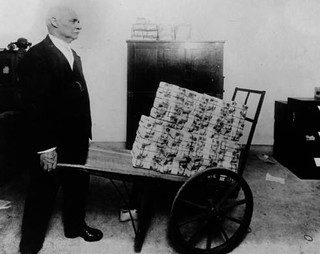
PREV ARTICLE
NEXT ARTICLE
FULL ISSUE
PREV FULL ISSUE
THE U.S. TREASURY DEPARTMENT MONEY LAUNDRYIn the literally-laundering-money department is this April 4, 2017 Atlas Obscura article about the old U.S. Treasury Department Laundry. -Editor
 Long before the term “money laundering” entered the popular lexicon, the U.S. Treasury Department had an actual laundry shop for grimy greenbacks. The mostly female “redemptive division” worked out of the basement and cleaned up to 80,000 soiled bills a day using mechanical scrubbers. The idea of a cash laundry goes back to 1910, when the Director of the Bureau of Engraving and Printing (a division of Treasury) was searching for a way to extend the lifespan of paper money; at the time small denomination bills lasted just over a year before they were so worn out that they had to be retired. A chemist at the bureau, Burgess Smith, came up with a mechanical device that could bathe, sterilize, and iron the grimy old bills with industrial efficiency. The invention took advantage of the fact that dollar bills are made out of a special blend of cotton and linen that doesn’t disintegrate in water. A 1912 Washington Post account described how the laundry had “dozens of rolls, many gears, and operates with the same clash and clang [as a printing press]. The money is placed between two canvas belts at one end of the machine. It runs through a solution of laundry soap and boiling hot water, where it is thoroughly cleansed. It then enters another vat in which there is a solution of stiffening material and germ-killing solution. From this vat it is drawn between a gas heated mangle, where it is ironed as stiff as new bills.”
The nation’s bankers, for their part, thought that the laundry was great. Bills that went through the scrubber were softer than fresh notes—an important factor for people who spent their day counting money by hand. The laundry shop used to be located in the basement of the Treasury Department, though nothing remains of it now, and it isn't clear where the particular room was. Tours of the Treasury Department can be arranged by submitting a request through your congressional office. Would anyone have a clue as to where exactly the room was located? Perhaps the images can help. I've included two of the three images published with the article, which probably
were taken from the referenced 1912 Washington Post article. -Editor
To read the complete article, see:
 Wayne Homren, Editor The Numismatic Bibliomania Society is a non-profit organization promoting numismatic literature. See our web site at coinbooks.org. To submit items for publication in The E-Sylum, write to the Editor at this address: whomren@gmail.com To subscribe go to: https://my.binhost.com/lists/listinfo/esylum All Rights Reserved. NBS Home Page Contact the NBS webmaster 
|
